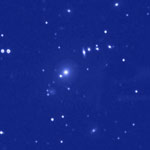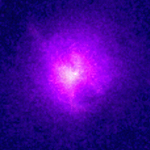Colossal Clouds of Hot Gas
The "X-ray universe" refers to the universe as observed with telescopes designed to detect X-rays. X-rays are produced in the cosmos when matter is heated to millions of degrees. Such temperatures occur where high magnetic fields, or extreme gravity, or explosive forces, hold sway.
Comparison of optical image from La Palma & B.McNamara (left) and X-ray imagefrom Chandra (right) of the Hydra A cluster of galaxies. This cluster is so large that it takes light millions of years to cross it.
Above is an example of one of the largest cosmic X-ray sources. This vast cloud of hot gas in a cluster of galaxies is several million light years across and contains enough matter to make hundreds of trillions of stars. The gas cloud is thought to have been heated by gravitational collapse when the universe was half its present size.
X-ray telescopes can also trace the hot gas from an exploding star or detect X-rays from matter swirling as close as 90 kilometers from the event horizon of a stellar black hole.
The Chandra X-ray Observatory, which was launched by Space Shuttle Columbia in 1999, can better define the hot, turbulent regions of space. This increased clarity can help scientists answer fundamental questions about the origin, evolution, and destiny of the universe.




